Mineur Study guides, Class notes & Summaries
Looking for the best study guides, study notes and summaries about Mineur? On this page you'll find 38 study documents about Mineur.
Page 2 out of 38 results
Sort by
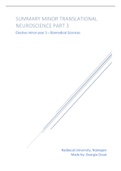
-
Summary Minor Translational Neuroscience part 3 - year 3 Biomedical Sciences/Medicine
- Summary • 27 pages • 2022
-
Available in package deal
-
- $7.64
- 4x sold
- + learn more
Alle stof van deel 3 uit de keuzeminor Translational neuroscience (jaar 3, Biomedical Sciences/Geneeskunde) samengevat aan de hand van de leerdoelen en begrippen en uitgelegd met illustraties. Bevat alle informatie uit hoorcolleges, zelfstudie, werkgroepen en practica.
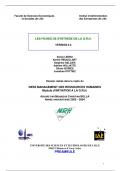
-
Human resources management hrm hrm summary sheets
- Summary • 229 pages • 2023
-
- $7.99
- + learn more
FICHE 0.1 : De la fonction personnel à la fonction RH PERIODES CARACTERISTIQUES Du Moyen Age à l’Ancien Régime Les relations de travail s’organisent dans le cadre des corporations de métiers (ex. : les compagnons du travail) : - Les corporations sont structurées suivant le niveau de formation : maîtrise/compagnon/apprenti. - Il s’agit d’espaces professionnels cloisonnés par métier où la sélection, la formation et la mobilité sont étroitement réglementées. Fin du X...
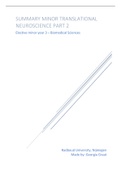
-
Summary Minor Translational Neuroscience part 2 - year 3 Biomedical Sciences/Medicine
- Summary • 31 pages • 2022
-
Available in package deal
-
- $7.76
- 3x sold
- + learn more
Alle stof uit deel 2 uit de keuzeminor Translational neuroscience (jaar 3, Biomedical Sciences/Geneeskunde) samengevat aan de hand van de leerdoelen en begrippen en uitgelegd met illustraties. Bevat alle informatie uit hoorcolleges, zelfstudie, werkgroepen en practica.
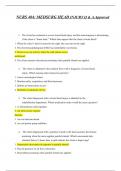
-
1. The client has sustained a severe closed head injury and the neurosurgeon is determining if the client is “brain dead.” Which data support that the client is brain dead? 1. When the client’s head is turned to the right, the eyes turn to the right. 2. T
- Exam (elaborations) • 27 pages • 2023
-
- $17.99
- + learn more
1. The client has sustained a severe closed head injury and the neurosurgeon is determining if the client is “brain dead.” Which data support that the client is brain dead? 1. When the client’s head is turned to the right, the eyes turn to the right. 2. The electroencephalogram (EEG) has identifiable waveforms. 3. There is no eye activity when the cold caloric test is performed. 4. The client assumes decorticate posturing when painful stimuli are applied. 2. The client is admitted t...
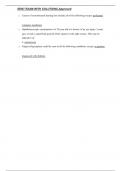
-
o Causes of sensorineural hearing loss include all of the following except: perforated tympanic membrane o Ophthalmoscopic examination of a 30-year-old w/a history of an eye injury 3 years ago, reveals a superficial grayish-white opacity in the right cor
- Exam (elaborations) • 19 pages • 2023
-
- $17.99
- + learn more
o Causes of sensorineural hearing loss include all of the following except: perforated tympanic membrane o Ophthalmoscopic examination of a 30-year-old w/a history of an eye injury 3 years ago, reveals a superficial grayish-white opacity in the right cornea. This may be indicative of a: corneal scar o Gingival hyperplasia could be seen in all the following conditions except: in patients diagnosed with diabetes o Examination of the eye reveals a painful, erythematous, and tender area...
![EAST 20 Antidepressants ethics[1] DOWNLOAD TO SCORE A Today’s prevailing model of depression is that it results from an imbalance of the neurotransmitters serotonin, nor epinephrine, and dopamine. This paper presents an alternative model, that is, that de](/docpics/63ea85a8f2b89_2367304.jpg)
-
EAST 20 Antidepressants ethics[1] DOWNLOAD TO SCORE A Today’s prevailing model of depression is that it results from an imbalance of the neurotransmitters serotonin, nor epinephrine, and dopamine. This paper presents an alternative model, that is, that de
- Exam (elaborations) • 19 pages • 2023
-
- $14.49
- + learn more
EAST 20 Antidepressants ethics[1] DOWNLOAD TO SCORE A Today’s prevailing model of depression is that it results from an imbalance of the neurotransmitters serotonin, nor epinephrine, and dopamine. This paper presents an alternative model, that is, that depression is best viewed as a pathologic form of grief response. This conceptual shift not only has a profound implications for research and clinical practice, but has ethical implications as well. Grief has evolved in Homo sapiens because of...
![EAST 20 Antidepressants ethics[1] DOWNLOAD TO SCORE A Today’s prevailing model of depression is that it results from an imbalance of the neurotransmitters serotonin, nor epinephrine, and dopamine. This paper presents an alternative model, that is, that de](/docpics/63ea84c447f68_2367286.jpg)
-
EAST 20 Antidepressants ethics[1] DOWNLOAD TO SCORE A Today’s prevailing model of depression is that it results from an imbalance of the neurotransmitters serotonin, nor epinephrine, and dopamine. This paper presents an alternative model, that is, that de
- Exam (elaborations) • 19 pages • 2023
-
- $14.49
- + learn more
EAST 20 Antidepressants ethics[1] DOWNLOAD TO SCORE A Today’s prevailing model of depression is that it results from an imbalance of the neurotransmitters serotonin, nor epinephrine, and dopamine. This paper presents an alternative model, that is, that depression is best viewed as a pathologic form of grief response. This conceptual shift not only has a profound implications for research and clinical practice, but has ethical implications as well. Grief has evolved in Homo sapiens because of...

-
14. Parkinsons disease is caused by loss of dopaminergic neurons of
- Exam (elaborations) • 1 pages • 2023
-
- $7.20
- + learn more
14. Parkinson's disease is caused by loss of dopaminergic neurons of the A. Cerebellum B. Basal ganglia (nuclei) C. Brainstem D. Primary motor cortex E. Thalamus 15. "Dual innervation" refers to an organ receiving A. two nerves from the spinal cord B. both autonomic and somatic neurons C. both sympathetic and parasympathetic neurons D. both spinal and cranial nerves E. none of the above 16. Effector organs of the autonomic nervous system include all of the following except A. Heart...

-
8. The dopamine beta-hydroxylase is an important enzyme found in neur
- Exam (elaborations) • 1 pages • 2023
-
- $7.20
- + learn more
8. The dopamine beta-hydroxylase is an important enzyme found in neural tissue that is responsible for creating norepinephrine dopamine norepinephrine HO HO dopamine - monooxygenase NH2 NH2 HO HO O2 ascorbic acid H20, dehydroascorbic acid While experimenting using in-vitro model of dopamine reactivity using PC12 cells, you find out that a substance DB15 can act as inhibitor. You have so far have studied three different concentrations of DB15 (11, 12 and 13), such that li Solution DB...
Notes of the lecture slides of Theories of Entrepreneurship and Innovation. Also the models and some things were explained a bit more in depth.

Do you wonder why so many students wear nice clothes, have money to spare and enjoy tons of free time? Well, they sell on Stuvia! Imagine your study notes being downloaded a dozen times for $15 each. Every. Single. Day. Discover all about earning on Stuvia



